Derby Lightweight (Yellow Diamond) 1, 2 & 4-car DMUs
North Eastern Region
The Region had received the first Derby Lightweight DMUs - the eight Red Triangle sets for the West Riding. For their next scheme, Newcastle - Middlesbrough services, it would receive five four-car Yellow Diamond Derby Lightweight sets which took over the services in November 1955. Future schemes would then be allocated Blue Square units. However the Region did a swap with the London Midland Region, switching two four-car Met-Camm units from a future build for four two-car Yellow Diamond Lightweights, which arrived in March 1956 and were intended for Newcastle - Hexham services.
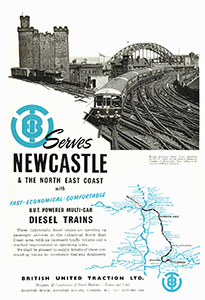
All seven sets (totalling 28 vehicles) would be allocated to South Gosforth (Newcastle), and would also work on other routes in the area.
Their inability to work with the later and more numerous Blue Square units became an issue, and as more Blue Square units arrived the use of the Yellow Diamond sets declined. Twenty-two vehicles were loaned to the Western Region at Cardiff in December 1959 for three months. One power-trailer set was withdrawn with accident damage (the DTC in November 1963 and DMBS in February 1964). The three remaining two-car sets moved to Cambridge in June 1965. Ten of the four-car vehicles were reallocated to the Scottish Region in August 1966, the remaining ten were withdrawn in November 1966 (nine) and January 1967 (one).
Preparation
The order for the five four-car sets was placed by the end of May 1954.
On Tuesday 19th October 1954 West Riding set 79007/79507 headed north via Ripon to Tyneside, carrying reporting number 92, arriving at Gosforth Car Sheds in the afternoon. The next day it made a performance trial run to assist in planning for the future service, departing Newcastle at 9.35am for Middlesbrough, calling at Sunderland and West Hartlepool. It returned from Middlesbrough at around 11.40am, and another round trip was made the following day.[1]
The planned introduction of diesels to the Newcastle - Sutherland - West Hartlepool - Middlesbrough services was publically announced by the North Eastern Region in May 1955, when they were expected to be introduced that autumn. Costing £500,000, they also mentioned plans for a replacement of steam on the Newcastle - Carlisle line and for local services to Hexham in 1956.[2]
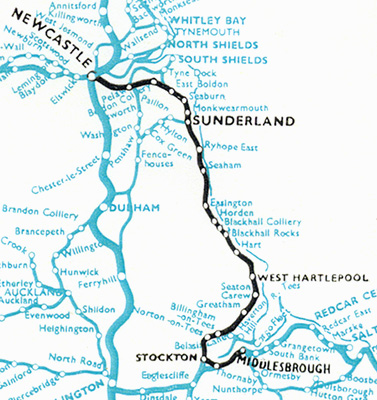
At the start of September 1955 it was announced that the new diesel trains on the North Eastern Region would be introduced in stages. During September and October trials and training would take place over branches in the Tyneside and Teeside areas, although there would be no passengers carried until the 7th November, when some Newcastle to Middlesbrough services would change over. The timings would be accelerated, arriving at Middlesbrough 10 minutes earlier, and leaving 10 minutes later arriving at Newcastle at the same time. This was to be the first use of four-car DMU sets, and the flexibility of the DMU operation helped to keep line occupation to a minimum, required on the intensively worked Newcastle to Middlesbrough route. It was hoped that the diesel workings on the line would be extended in Spring 1956, and sets introduced on Darlington to Saltburn services at the end of 1956 / beginning of 1957.
In September 1955 the first four-car set arrived at South Gosforth electric car sheds, where they would be allocated, and where a four road extension was planned in order to accommodate the DMUs. The set ran trials on the branch from Gosforth to Ponteland before running to Middlesbrough and back on the 14th September 1955.[3]
The RCTS photo site contains a photo of a set on a driver training run at West Gosforth on 27th September 1955.
The new sets travelled north from Derby to Gosforth via Wath Road, Normanton and York. The four-car sets were noted running trials on the main line from Newcastle to York. On October 11th set 79153/328/403/511 was noted, and there was a speed test booked for the 21st. This was allowed 89 mins in both directions for the 80.1 miles, the up-journey including a one-minute stop at Darlington and five-minutes recovery time.
On the 3rd November 1955 a set operated a trial trip from Middlesbrough - Scarborough and back, seemingly a normal occurance with the new deliveries from Derby.
On Saturday 19th November 1955 an eight-car formation operated a football special from Newcastle to West Hartlepool taking passengers to a first round FA cup match (Hartlepools United vs. Gateshead), and is believed to be the first use of an eight-car DMU formation in public use. The next day three sets were put into operation on the South Shields branch, the electric service having been withdrawn due to relaying operations at Gateshead.[4]
Services Start
They were introduced two weeks late on Monday 21st November 1955 to seven of the hourly services each way between Newcastle, Sunderland, West Hartlepool and Middlesbrough. In most cases timings were 12-15 mins quicker than the steam trains they replaced. There were seven services in each direction, including Sundays, although Sundays were at different times. The weekdays 7am Newcastle to Middlesbrough train was scheduled for an eight-car set, covering the 47 miles 18 minutes quicker than the previous schedule. The 9.35pm from Middlesbrough made a reduction of 22 minutes. Light refreshments - but not alcohol - was served by trolley (pictured) on the 7.00am and 11.15am from Newcastle, and the 9.35am and 3.35pm from Middlesbrough.[5]
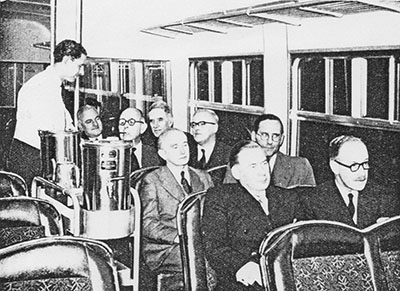
On Sundays the 6.15pm Newcastle to Sunderland was extended to Middlesbrough and the 7.15pm and 9.15pm were both put back one hour, and from Middlesbrough the 8.35pm and 9.45pm were also now diesel operated.
Cheap day return fares were available for any train on any day, working out at less than a penny-a-mile for third class travel to/from Newcastle.
The annual operating savings for these 4-car sets was £18,744.
On Wednesday, 14th December 1955, a fault in the switchgear at Stella South power station at around 8.30am resulted in a complete power failure over a large area of Northumberland and Durham. It seriously affected transport in the Tyneside area, and at least two of the four-car Derby Lightweight sets were brought into use to provide a skeleton service on the North Tyneside electric lines.
Problems
1956 did not start well for the new diesels. On January 7th the set for the 2.15pm from Newcastle failed, with departure delayed till 2.55pm using the set for the 3.15pm, the later turn was steam worked. Later the same day another set hit the buffers at Newcastle Central causing some damage to the front end; it would go to York Works for repair later in the week. Around the same time after another set also substained damage after running through a set of catch points at Gosforth. These incidents meant that beginning January 7th many of the booked DMU Newcastle - Middlesbrough services were worked by steam.[6]
On the 10th January 1956 all the diesel turns were noted as being worked by steam. On the 14th one eight-car formation was in traffic, the other turns were steam hauled.
On the 31st January 1956 steam worked the 12:35 Middlesbrough - Newcastle turn.
On the 7th February 1956 the vehicle which had bent an axle in the catch point derailment at Gosforth in January was returned to Gosforth, hauled north from York by a B16. Two days later four vehicles were returned after buffer repairs to the damage sustained on January 7th at Newcastle Central. Two four-car sets were working the 7.00 am Newcastle - Middlesbrough on the 10th February 1956, and as the formation was approaching East Boldon the fluid flywheel on one of the engines on the rear set caught fire. The train was brought to a stand at East Boldon station where the fire was put out. The front set continued to Middlesbrough, the rear set was put into a siding and later hauled away by B16 61423.[7]
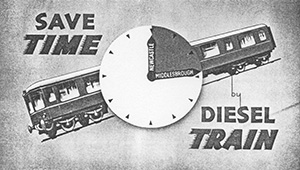
The image shows a window display that promoted the Newcastle - Middlesbrough services - the vehicle does look a little longer than it should![8]
On the 13th March 1956 the electric set working the 1.15pm from Newcastle to Newcastle via Wallsend, Tynemouth and Backworth failed near Backworth and was replaced by a four-car Derby Lightweight.
New Arrivals
During the w/e 17th March 1956 two 2-car Derby Lightweight sets (79137/8 with 79658/9) arrived at Gosforth, intended for the Newcastle - Hexham services which were scheduled for DMUs later in the year. These sets were put to use in the meantime for relief and strengthening the Newcastle - Middlesbrough service, allowing normal services to resume from Monday 19th March 1956 after the mishaps earlier in the year.[9]

In the image two two-car sets head out of Newcastle with a Middlesbrough service. The date is unknown, they appear reasonably clean so probably taken soon after delivery. British Railways.
During the week commencing 19th March 1956 work began on the four road extensions to the sidings at Gosforth car sheds. The shed as was could handle the Lighweights and the four-car (Met-camm) sets for the Newcastle - Carlise services due to arrive from October, but the expansion was for later deliveries. By the end of March another two power-trailer Derby Lightweight sets (79139/40 with 79660/1) arrived at the depot, the last Derby Lightweights it would receive.
In May 1956 Newcastle sets 79152/328/510 and 79153/329/511 were sent to augment the Bradford Red Triangle sets, which were all running as 4-car sets, for the holiday traffic to Knaresborough.[10]
It was noted that from around May 1956 there was a Friday only DMU service operated by a three-car set (a four-car with the trailer second removed?) departing Newcastle at 1.0pm that went to the Harrogate Area, returning the next day. It was due to be operated by a six-car set from July 7th. On June 20th 1956 a charter by the "Illuminating Engineers' Society" used a Lightweight on a trip from Newcastle to Morpeth, Reedsmouth before returning to Newcastle, with a stop at Bellingham along the way.[11]
The Newcastle sets helped out the Bradford sets again during the 1956 August Bank Holiday when a half-hour service was run between Bradford and Knaresborough. There were six special diagrams, four worked by the eight Bradford sets made up into four 4-car sets, the other two were covered by 79153/328/511 and 79154/325/510. There were also two diagrams for steam specials from Leeds to Knaresborough. On the 7th August one diesel and both steam diagrams were dropped.[12]

The image shows four-car set E79510 + E79326 + E79400 + E79153 at Tebay on 15th September 1956 while working a joint RCTS / BR tour 'The Little North Western' that started from Leeds. Stuart Mackay Collection.
The four-car Met-Camm sets began to arrive at South Gosforth in mid-October 1956, and were soon noted working on the Newcastle - Middlesbrough services on Lighweight turns. Intended for the Newcastle - Carlisle service, these new arrivals would not take over that service until February 4th, 1957.
With two types now based at Newcastle, it now wasn't easy to tell what types are referred to in notes. Engineering work to the east end of Newcastle Central station on November 18th and 28th 1956 saw DMUs (which type?) operate the normally electric services to South Shields, diverted via the King Edward bridge.[13]
New Duties
The diesel railcars had not taken over every Newcastle - Middlesbrough service, this did not happen until the introduction of the winter 1957 timetable.[14] A further batch of four-car Met-Camms began to arrive in September 1957, allowing Met-Camm units to begin operating Newcastle-Middlesbrough services from the new timetable on September 16th, eliminating steam. The Derby Lighweight stock was transferred to Newcastle - Carlisle turns.[15]
During October 1957 there was engineering work on the High Level Bridge at Newcastle on Sundays, and four-car DMUs (type unknown) operated the South Tyneside electric services.[16]
These substitutions were far from unusual, another occurance was in 1959 when on Sundays from 22nd February to 3rd May DMUs again worked the South Shields electric duties when High Level bridge was closed, diverted via the King Edward Bridge and reversing into and out of Gateshead (West) station.[17]
South Wales
At the end of 1959 Cardiff Cathays depot loaned the London Operating District a batch of suburban triple sets to help with a crisis. Cathays then borrowed twenty-two of the twenty-eight Yellow Diamond vehicles from South Gosforth. Of the vehicles that did not move, four were from four-car sets (79152/3, 79329, 79404) and two (79138/79660) were from a two-car, meaning three four-car sets (one with a motor composite on both ends) and three two-cars were sent by the NER, these being surplus to the winter timetable requirements.[18] It was noted that "from the condition of the driving compartments and the mechanical equipment these appear to have been little used for some while." In South Wales they were noted working on the Rhymney, Penarth and Barry lines.[19], their use on the Cardiff Valley services dictated by their lack of WR ATC gear.
This image on flickr shows a set at Cardiff with Cadoxton on the destination blind. The sets returned to South Gosforth in March 1960, and this image shows a set on Cardiff Cathays depot, E79510 displaying Cardiff Queen Street on the destination blind.
The End
The note about apparent lack of use suggests that the influx of Met-Camm units and the non-standard coupling code relegated them to only being used where necessary. The ease in which South Gosforth could spare twenty-two vehicles, and the lack of photographs of vehicles in service on the North Eastern Region at this time also suggests this.

Seen in the image at York station on May 19th 1962 is E79152 at the front of the 11.35am Newcastle - Leeds City. It seems un-repainted since new as all vehicles still have the original lion over wheel crests. The cab front has had whiskers applied, and a dummy socket added for the jumper cables. There could be draft problems in the cab judging by the amount of papers shoved down the front of the drivers desk.

The second image two of the two-car sets in Newcastle Central on May 21, 1962. Both Michael Mensing.
The occassional use that they did see resulted in a two-car set being written off with accident damage (details of the incident are unknown). The DTC (79659) was withdrawn on November 3rd, 1963, and the DMBS (79139) on February 17th, 1964.
An eight-car set worked the Consett - Waskerley portion of the RCTS "North Eastern No.2" rail tour on April 10th 1965. A picture of the tour at Waskerley can be found on the Disused Stations website.
The three remaining two-car sets moved to Cambridge in June 1965, where they remained until withdrawal in June 1968.
Ten of the four-car vehicles went on loan to the Scottish Region at Leith Central in August 1966. However is seems that not all reached Scotland, some just went into store at Heaton, and many that did make it across the border went into store there.[20] By the end of the year the ScR had another ten vehicles from Bletchley and Norwich which it would put into use instead.
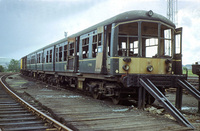
Nine of the ten vehicles that remained allocated to South Gosforth were withdrawn on November 21st 1966, the final one (79404) on January 22nd 1967. The image shows E79150 and E79402 at the depot on 15 August 1970. They would be cut up there in July 1971. David Mant.
The Scottish Region withdrew all its Derby Lightweights on June 12, 1967. Interestingly most of the NER vehicles returned to the NER, being stored at Darlington before disposal at various locations. The only ones that seem to have been scrapped in Scotland were the Motor Composites.
A section on this video shows withdrawn Derby Lightweight vehicles, including E79153. They are noted as being at Chester MPD, but E79153 has been noted as remaining in the north east after withdrawal and being cut up at Heaton.
References
- ⋏ November 1954, p340 Railway Observer
- ⋏ p559 May 20th 1955 Railway Gazette
- ⋏ October 1955, p321 Railway Observer
- ⋏ December 1955, p396 Railway Observer
- ⋏ p636 November 25th 1955 Railway Gazette
- ⋏ February 1956, p56 Railway Observer
- ⋏ March 1956, p80 Railway Observer
- ⋏ p250 April 20th 1956 Railway Gazette
- ⋏ NER Regional Operating Officers' Conference 9 April 1956 Minute 4b
National Archives - AN105-4 Departmental Officers' conferences and monthly meetings - ⋏ June 1956, p181 Railway Observer
- ⋏ July 1956, p216 Railway Observer
- ⋏ September 1956, p274 Railway Observer
- ⋏ January 1957, p22 Railway Observer
- ⋏ October 1957, p276 Railway Observer
- ⋏ November 1957, p309 Railway Observer
- ⋏ November 1957, p305 Railway Observer
- ⋏ April 1957, p362 Railway Observer
- ⋏ Photo caption for "DMU E79510 1960 Cardiff Cathays" on Rail Online website, accessed 21 June 2020
- ⋏ February 1960, p47 Railway Observer
- ⋏ December 1967, p424 Railway Observer
The Railway Observer is the journal of the Railway Correspondence and Travel Society
Summary
Description
- Single cars
- Four-car sets
Drivers Instructions
Numbering
Liveries
Operations
- West Cumberland
- Lincolnshire
- East Anglia
- North Eastern Region
- Buckingham - Banbury
- Manchester
Non-Passenger Use
- Special Saloon
- Ultrasonic Test Train
Images
Details about preserved Derby Lightweights can be found here.


